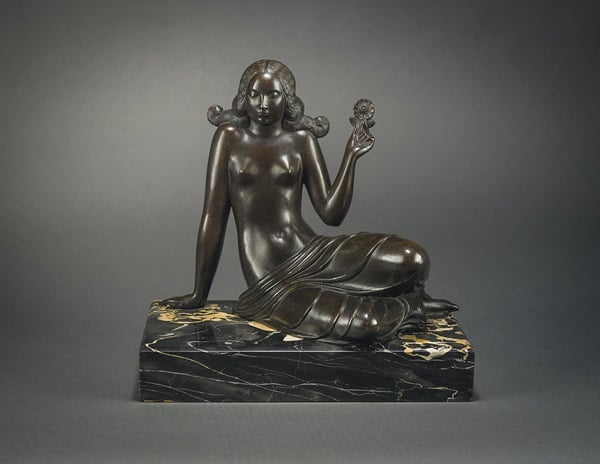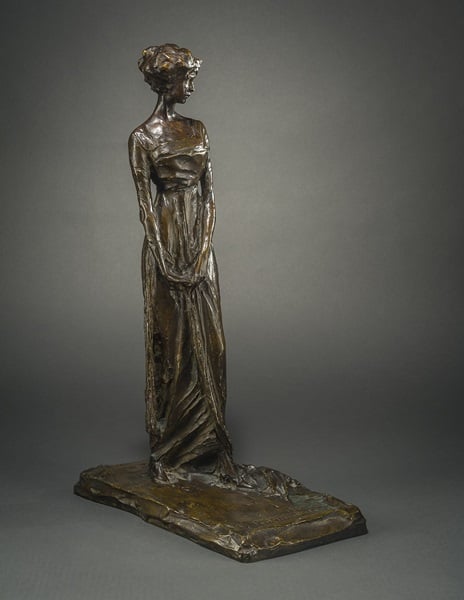Analysis
Bronze Statues Recovered 32 Years After ‘Broad Daylight’ Theft in New York
The dealer stumbled upon the claims before the Winter Antiques Show.

The dealer stumbled upon the claims before the Winter Antiques Show.

Eileen Kinsella


Prince Paul Troubetzkoy Figure of Gertrude Vanderbilt Whitney (1910) cast bronze, Photo: Courtesy Hirschl & Adler Gallery
Two unique bronze sculptures that were stolen from a New York gallery and turned up 32 years later on consignment to a different New York gallery, have been recovered, according to London-based Art Recovery International, which helped negotiate the settlement and return.
The saga started in December 1983 when Paul Manship‘s Central Figure of Day (1916) was stolen from a sculpture show at New York’s Hirschl & Adler Gallery. A mere three weeks later, Prince Paul Troubetzkoy’s Figure of Gertrude Vanderbilt Whitney (1910) was stolen from the same show. (Ahem . . . can you say ‘inside job’?)
Hirschl & Adler treasurer Ray Lazerson remarked: “There can’t be too many dealers who have to tell their gallery director twice in three weeks that something has been stolen!”

Paul Manship Central Figure of Day (1916) cast bronze. Photo: Courtesy Hirschl & Adler.
The thefts were reported to the Art Dealers Association of America (ADAA), which runs an appraisal service in addition to organizing the prestigious annual Art Show at the Park Avenue Armory (see artnet Asks: Dorsey Waxter, ADAA President and New York Gallerist). The sculptures were appraised at approximately $24,000 each, though together they now carry an estimated market value of about $250,000, according to a statement from Art Recovery (see Your Prized Picasso is Missing. Now What?!)
This past December, the two works were eventually consigned to the Gerald Peters Gallery, which specializes in American art and has branches in Manhattan as well as in Santa Fe, New Mexico. As part of its due diligence before exhibiting the works at the 2015 (January 23–February 1) Winter Antiques Show (see The Winter Antiques Show Surprises With a Range of Offerings), gallery officials stumbled upon the outstanding, and still active, claims on the works.
Art Recovery, which was founded by recovery expert Christopher Marinello, was then appointed to lead negotiations between all the parties involved in the matter and resolve the dispute. Talks began late this past year, according to a statement by Art Recovery, and the works were “recovered without condition.” On February 6, the works were given back to Hirschl & Adler.
“It’s never too late to pursue a claim,” said Marinello, noting that the case serves as a lesson to loss victims. “Thirty years is a long time for something to go missing in the art world but thanks to more and more galleries undertaking due diligence we have a better chance than ever of recovering long-lost works of art.” (See: Christopher Marinello is the Sherlock Holmes of Art Crime.)
“We are delighted that these works have been found, and grateful for the cooperation of all parties in their recovery,” said Lazerson.
Marinello said the legal process of determining ownership in this case presented “very few obstacles.” According to the Art Recovery statement, unlike the legal systems in most European countries, it is a basic tenet of US law that no individual can obtain good title to a stolen work of art—not even when purchased in good faith (see Getting Good Title to Art You Purchase). The law recognizes that a stolen work of art is always stolen property and therefore makes no exceptions for good faith, passage of time, or the number of owners since the theft occurred.
Apparently Paul Manship was a hot ticket and a favorite target for art thieves back in the day. In 1990, the New York Times reported on the recovery of Manship’s Aries the Ram and Taurus the Bull from his “Armillary Sphere” series created for the 1964 New York World’s Fair. Several of the works in the series were stolen in the early 1970s.